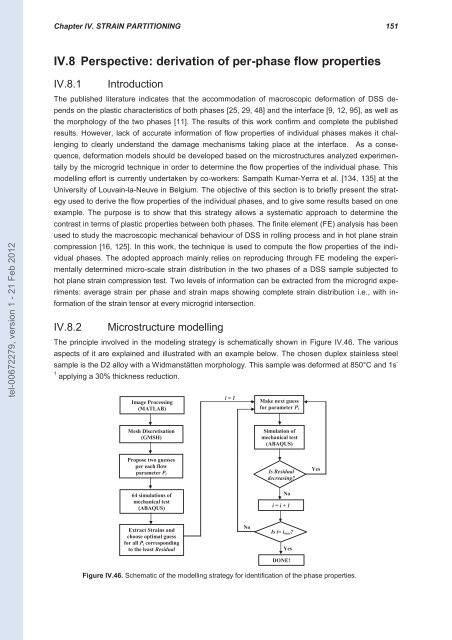Forgeabilité des aciers inoxydables austéno-ferritiques
Forgeabilité des aciers inoxydables austéno-ferritiques
Forgeabilité des aciers inoxydables austéno-ferritiques
Create successful ePaper yourself
Turn your PDF publications into a flip-book with our unique Google optimized e-Paper software.
tel-00672279, version 1 - 21 Feb 2012<br />
Chapter IV. STRAIN PARTITIONING 151<br />
IV.8 Perspective: derivation of per-phase flow properties<br />
IV.8.1 Introduction<br />
The published literature indicates that the accommodation of macroscopic deformation of DSS de-<br />
pends on the plastic characteristics of both phases [25, 29, 48] and the interface [9, 12, 95], as well as<br />
the morphology of the two phases [11]. The results of this work confirm and complete the published<br />
results. However, lack of accurate information of flow properties of individual phases makes it chal-<br />
lenging to clearly understand the damage mechanisms taking place at the interface. As a conse-<br />
quence, deformation models should be developed based on the microstructures analyzed experimen-<br />
tally by the microgrid technique in order to determine the flow properties of the individual phase. This<br />
modelling effort is currently undertaken by co-workers: Sampath Kumar-Yerra et al. [134, 135] at the<br />
University of Louvain-la-Neuve in Belgium. The objective of this section is to briefly present the strat-<br />
egy used to derive the flow properties of the individual phases, and to give some results based on one<br />
example. The purpose is to show that this strategy allows a systematic approach to determine the<br />
contrast in terms of plastic properties between both phases. The finite element (FE) analysis has been<br />
used to study the macroscopic mechanical behaviour of DSS in rolling process and in hot plane strain<br />
compression [16, 125]. In this work, the technique is used to compute the flow properties of the indi-<br />
vidual phases. The adopted approach mainly relies on reproducing through FE modeling the experi-<br />
mentally determined micro-scale strain distribution in the two phases of a DSS sample subjected to<br />
hot plane strain compression test. Two levels of information can be extracted from the microgrid expe-<br />
riments: average strain per phase and strain maps showing complete strain distribution i.e., with in-<br />
formation of the strain tensor at every microgrid intersection.<br />
IV.8.2 Microstructure modelling<br />
The principle involved in the modeling strategy is schematically shown in Figure IV.46. The various<br />
aspects of it are explained and illustrated with an example below. The chosen duplex stainless steel<br />
sample is the D2 alloy with a Widmanstätten morphology. This sample was deformed at 850°C and 1s -<br />
1 applying a 30% thickness reduction.<br />
Image Processing<br />
(MATLAB)<br />
Mesh Discretisation<br />
(GMSH)<br />
Propose two guesses<br />
per each flow<br />
parameter Pi<br />
64 simulations of<br />
mechanical test<br />
(ABAQUS)<br />
Extract Strains and<br />
choose optimal guess<br />
for all Pi corresponding<br />
to the least Residual<br />
Is Residual<br />
decreasing?<br />
DONE!<br />
Figure IV.46. Schematic of the modelling strategy for identification of the phase properties properties.<br />
i = 1<br />
No<br />
Make next guess<br />
for parameter Pi<br />
Simulation of<br />
mechanical test<br />
(ABAQUS)<br />
No<br />
i = i + 1<br />
Is i= imax?<br />
Yes<br />
Yes

















